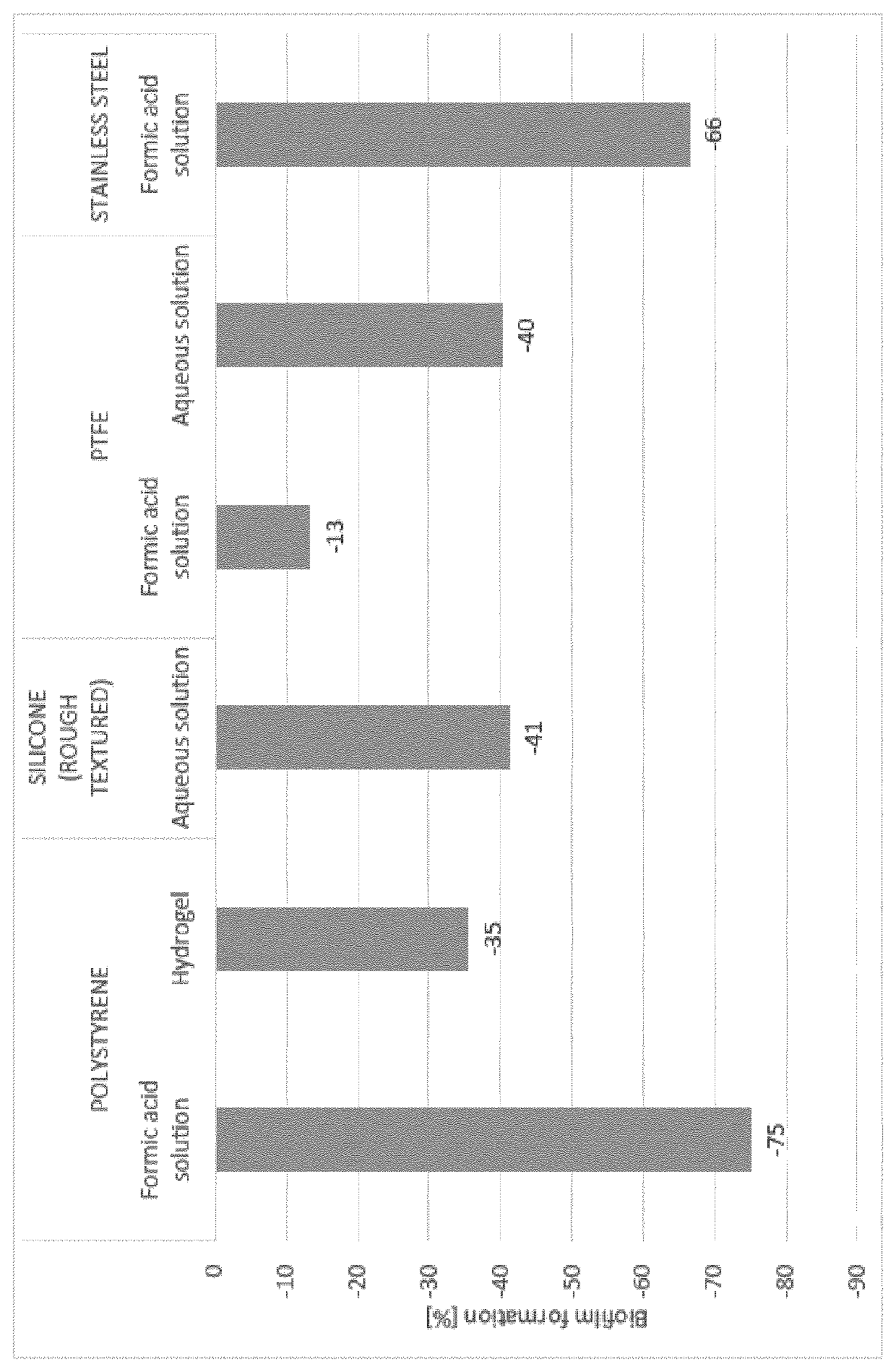Use of bipolymer for reducing the formation of a biofilm
a biofilm and bipolymer technology, applied in the field of biofilm formation reduction, can solve the problems of biofilm formation in water cooling towers for air conditioners, biofilm formation is well known to public health risks, and the flow of turbulent fluid over the surface is not protected, so as to avoid or reduce the formation of biofilm
- Summary
- Abstract
- Description
- Claims
- Application Information
AI Technical Summary
Benefits of technology
Problems solved by technology
Method used
Image
Examples
example 1
on of the Coating Solution / Hydrogel
[0126]The C16 protein was prepared as described in WO 2006 / 008163.
a) Preparation of a C16 Protein Aqueous Solution:
[0127]C16 protein was dissolved in 6 M GdmSCN, diluted with 5 mM Tris / HCl pH 8.5 to 0.6 M GdmSCN. The solution was cross-filtrated against 4 M Urea (10-15×) and then cross-filtrated against 5 mM Tris / HCl pH 8.5 (Crossflow; Vivaflow 10-20×) until no urea was detectable.
[0128]Alternatively, C16 protein was dissolved in 6 M GdmSCN, diluted with 5 mM Tris / HCl pH 8.5 to 0.6 M GdmSCN. The protein solution was cross-filtrated against 5 mM Tris / HCl pH 8.5 (Crossflow Vivaflow 10-20×) until no GdmSCN was detectable.
[0129]14 ml of C16 protein aqueous solution (C16 protein solution in 5 mM Tris, pH 8.5; protein concentration 12.5 g / l) were filled up to a final volume of 17 ml with deionized water to final protein concentration of 10 g / l.
b) Preparation of a C16 Protein Hydrogel:
[0130]30 ml of a C16 protein solution (C16 protein solution in 5 mM Tri...
example 2
on of the Substrates
[0133]The different substrates were prepared as follows:
a) Preparation of the polytetrafluorethylene (PTFE) substrates: PTFE patches with a diameter of 5 mm were punched out using a commercial perforator and glued to the bottom of a 96 well plate using Sylgard 184 silicone (Swiss-composite).
[0134]b) Preparation of the stainless steel substrates: stainless steel patches (Product Nr. FK110250 / 1, 300649549, GoodFellow) with a diameter of approx. 5 mm were punched out using a commercial perforator, flattened with a hammer and glued to the bottom of a 96 well plate using Sylgard 184 silicone (Swiss-composite).
c) Preparation of polystyrene substrates: the untreated wells of a polystyrene 96-well plate were used as substrate.
[0135]For coating of the polytetrafluorethylene, stainless steel and polystyrene substrates with a C16 protein hydrogel, 75 μl of a 1% C16 protein hydrogel were pipetted into the wells of a 96-well plate and dried overnight. The next day, 50 μl of m...
example 3
tion of the Biofilm Formation on Different Coated Substrates
[0141]In order to test the biofilm formation, polystyrene 96-well plates (Greiner bio-one, PS, flat bottom) assembled with different substrates (polystyrene, rough textured silicone, polytetrafluorethylene (PTFE) and stainless steel) were coated with the silk biopolymer according to example 2. As a control, uncoated substrates were used. The 96-well plates were incubated with an adherent bacterial culture of biofilm-forming bacteria (Staphylococcus aureus). After incubation, the number of bacterial cells grown on the 96 well plates was determined and compared to the number of bacterial cells grown on the respective substrates without silk biopolymer coating.
[0142]In particular, an inoculum of 200 μl of Staphylococcus aureus in culture medium (0.5% TSB (tryptic soy broth) with yeast peptone dextrose) was added to the 96-well plates. Culture medium (0.5% TSB (tryptic soy broth) with yeast peptone dextrose without Staphylococc...
PUM
| Property | Measurement | Unit |
|---|---|---|
| temperature | aaaaa | aaaaa |
| thickness | aaaaa | aaaaa |
| thickness | aaaaa | aaaaa |
Abstract
Description
Claims
Application Information
 Login to View More
Login to View More - R&D
- Intellectual Property
- Life Sciences
- Materials
- Tech Scout
- Unparalleled Data Quality
- Higher Quality Content
- 60% Fewer Hallucinations
Browse by: Latest US Patents, China's latest patents, Technical Efficacy Thesaurus, Application Domain, Technology Topic, Popular Technical Reports.
© 2025 PatSnap. All rights reserved.Legal|Privacy policy|Modern Slavery Act Transparency Statement|Sitemap|About US| Contact US: help@patsnap.com

